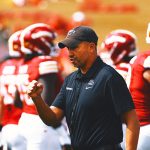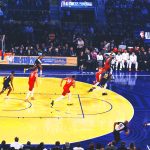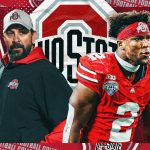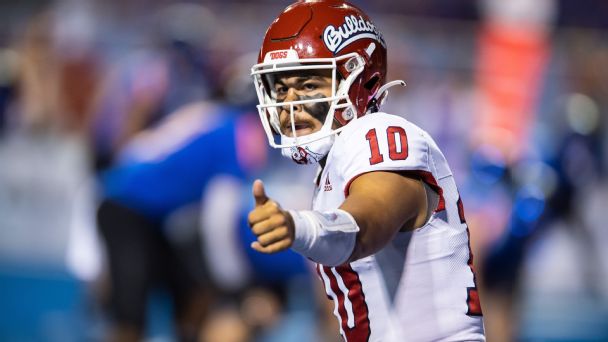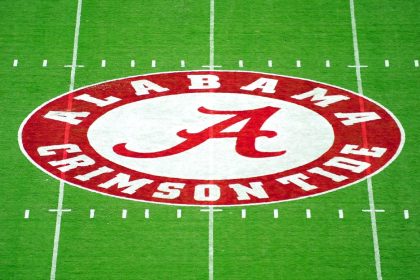
The Mountain West is a conference for familiar faces. Fresno State and San Diego State are currently run by head coaches in their second respective tenures there (Jeff Tedford in Fresno, Brady Hoke in San Diego). Boise State is run by former Bronco linebacker Andy Avalos, Air Force by former Falcons quarterback Troy Calhoun, Nevada by former longtime assistant Ken Wilson, New Mexico by former Lobo linebacker (and punter!) Danny Gonzales and Hawai’i by former million yard Warrior quarterback Timmy Chang.
This is more “fun tidbit” than “useful quality indicator,” of course. These familiar faces couldn’t stop the MWC from an all-time low average SP+ ranking last season. But they add an extra layer of narrative interest to the proceedings, at least.
One of these familiar faces will likely win the conference this fall, too. Tedford did so last season, and at first glance it looks like a potential rematch between his Bulldogs and Avalos’ Broncos could await in the 2023 MWC championship.
Can Fresno State repeat despite key changes on offense? Can SDSU disrupt the path toward a rematch? Can a high potential San Jose State make a charge after a couple of stagnant years? Did UNLV make the right choice in firing a coach as he was making visible improvements? What happens after full-on Year Zeroes for Nevada and Hawai’i?
We previewed the six teams in the former MWC Mountain last week; this week, let’s look at the six teams formerly known as the MWC West.
Every week through the offseason, Bill Connelly will preview another division from the Group of 5 and Power 5 exclusively for ESPN+, ultimately including all 133 FBS teams. The previews will include 2022 breakdowns, 2023 previews and burning questions for each team.
Earlier previews: Conference USA, part 1 | Conference USA, part 2 | MAC East | MAC West | MWC Mountain

2022 recap
1:54
Washington State Cougars vs. Fresno State Bulldogs: Full Highlights
Washington State Cougars vs. Fresno State Bulldogs: Full Highlights
Jake Haener ended up going out on top. The Fresno State quarterback was recruited to town by Tedford, thrived under Tedford’s successor Kalen DeBoer and nearly transferred when DeBoer left for Washington. But when Tedford replaced his replacement, Haener stuck around.
Injury troubles for Haener and others triggered a dismal 1-4 start for the Bulldogs, but once things clicked, they clicked. They won their last nine games of the season, four by at least 27 points, and avenged an early season 40-20 loss at Boise State by returning to Boise for the MWC championship and winning by 12. To finish off an incredible run, they manhandled Washington State in the LA Bowl. After underachieving SP+ projections by an average of 17.5 points per game over the first five games, they overachieved by 11.3 per game over their final nine. San Diego State and San Jose State both looked like potential West division contenders early in the year, but both fell by the wayside, and Fresno State won its fourth title in 10 years.
There are basically two projected tiers to the MWC this fall: the contenders and the also-rans. Fresno State, Boise State, Air Force and San Diego State have combined to snare 15 of 20 all-time spots in the MWC championship, and they’re all projected between 67th and 80th in SP+. The other eight teams are all 101st or lower. SJSU has disruption potential, but a rough schedule — it plays each of the top four teams and it draws a UNLV team of similar potential quality on the road — might hold the Spartans back, and the most familiar faces in the MWC title race are the most likely faces in this one.
Burning questions
This isn’t going to be like the last time a Jeff Tedford team dealt with turnover, right? In his first year at Cal in 2002, Tedford engineered a leap from 1-10 to 7-5. In the first year of his first stint at Fresno State, his Bulldogs leaped from 1-11 to 10-4. In his second go-round with the Bulldogs, he inherited a strong team (Fresno State was 10-3 in 2021) and kept it strong (10-4 with a MWC title in 2022).
Few hit the ground running like the 61-year-old Tedford, who’s won or shared three conference titles and won 118 games in 15 years as a college head coach. He nearly took Cal to a BCS bowl in the 2000s and engineered three ranked finishes, and in Fresno he’s won double-digit games in three of four total seasons. But when the end arrives, it arrives suddenly. His last Cal team dropped from 7-6 to 3-9 in 2012, and after starting his first Fresno tenure at 22-6, he suddenly went 4-8 in 2019 and resigned for health reasons. That Bulldogs squad battled a huge load of turnover and fell apart before Tedford’s successor, Kalen DeBoer, reignited things. DeBoer left for Washington, so a rested Tedford tagged back in and guided a veteran squad well.
His 2023 squad will not have quite as many veterans. Quarterback Jake Haener, 1,300-yard rusher Jordan Mims, four of last year’s top five wideouts and half the two-deep in the secondary are all gone, as is offensive coordinator Kirby Moore, who left for Missouri. The lines are big and experienced, and that should assure a pretty high floor for the Bulldogs, but Tedford has a lot of new pieces to break in.
The backfield will still have experience, at least. Either junior Logan Fife or UCF transfer Mikey Keene will likely start at quarterback; they have combined for more than 3,000 career passing yards (mostly from Keene). Malik Sherrod and Cal transfer Damien Moore should suffice at running back, too. Tedford signed four junior college transfers to plump up the receiving corps, but that unit will remain a concern until proven otherwise.
Even if the offense is scuffling to hold steady this fall, that might be all right — the defense carried much of the weight for the Bulldogs in 2022 (it was 36th in defensive SP+) and returns eight of the 11 players with 400-plus snaps. Veteran coordinator Kevin Coyle has to replace by far his best pass-rusher (end David Perales) and his top three safeties, but the spine of the defense will feature veteran stars in defensive tackle Johnny Hudson Jr., inside linebacker Levelle Bailey and corners Cam Lockridge and Bralyn Lux. A quick game of count the transfers tells you where the concerns lie: Tedford signed nine transfers or jucos on offense and just four on defense.
Even with an offense projected to fall into the 80s, Fresno State is a projected favorite in 10 of 12 games, per SP+, and has about a 1-in-3 chance of going 10-2 or better. Even without divisions, the most likely 2023 MWC championship will be a repeat of last year’s. But there are just enough question marks here to open the door for challengers.
Is SDSU going to find an offense before it finds the Pac-12? Conference realignment plot twists have the tendency of appearing suddenly and out of nowhere, like Beyoncé albums or my Chihuahua when I open a bag of chips. Maybe we end up with another blindsiding blockbuster this summer, but as of now it seems we know the next few potential developments: First, Pac-12 commissioner George Kliavkoff will finally release the details and possible financial value of a new, USC- and UCLA-less media deal. Either it will provide enough value to keep the conference’s 10 remaining schools aboard, or the Big 12 will try to pluck away the most geographically sensible of the bunch. Assuming the former, the Pac-12 will likely soon announce a couple of expansion targets thereafter. One of those will almost certainly be San Diego State.
Such a move would make sense, of course. SDSU offers a home for the conference in Southern California, and the potential of the athletic program is obvious. The Aztecs just reached men’s basketball’s Final Four, they have won or shared three MWC football titles in the past 11 years and they’ve been bowl-eligible for 13 years running. They ripped off five seasons of double-digit wins in seven years between 2015 and 2021, and they have averaged rankings of 20.3 in defensive SP+ and 21.7 in special teams SP+ in that span. They’ve basically been a power conference football program for going on a decade, in other words.
They haven’t had a power conference offense, however. Another average ranking from that span: 99.7 in offensive SP+. That’s sunk to 114.2 over the past five years; they were 123rd in 2022. Fourth-year head coach Brady Hoke (like Tedford, on his second stint at his current school) inherited this imbalance from predecessor Rocky Long and furthered it, and now he’s hoping the quarterback of SDSU’s last genuinely good offense will fix it. Ryan Lindley, the Aztecs’ quarterback when they ranked 39th in 2010, signed on as QBs coach last October and is now offensive coordinator. In theory, his charges have a lot of potential.
Quarterback Jalen Mayden, running back Kenan Christon and tight end Mark Redman were all high three-star or low four-star P5 recruits initially, and SDSU has long averaged steady mid-three-star recruiting on its own. The offense definitely perked up when Mayden took over starting in October — they averaged 19 points per game and 4.4 yards before that and 23 and 5.6, respectively, after — and Christon gained 468 yards in just 80 touches last year (though a lot of that came on just a couple of receptions). Conservatism and predictability have long been issues; we’ll see if the 33-year-old Lindley brings some new ideas to the table and executes them properly.
The defense has earned the benefit of the doubt here, dominating through the years despite head coach and coordinator changes. Current coordinator Kurt Mattix has been great, and his secondary would already be one of the better units in the Pac-12. But the front six is getting a massive makeover: Of the seven linemen and linebackers who saw over 400 snaps last year, only one returns. New Mexico linebacker transfer Cody Moon should help immediately, but three jucos and Oklahoma State tackle transfer Samuela Tuihalamaka will have to thrive immediately to ward off at least temporary regression.
Does the chip-on-shoulder routine work in Sin City? Put Barry Odom in charge of an underdog, and he’ll probably thrive. Per SP+, he produced two top-40 defenses as coordinator at Memphis in the mid-2010s, he produced two top-10 defenses as coordinator or head coach at Missouri, and in his first two years as coordinator at Arkansas, he inherited a unit that ranked 98th and flipped it to 30th. It slid to 68th last season after a load of both hype and turnover, but the fewer expectations he has, the better he seems to perform, and he was at least decent as Mizzou’s head coach, guiding the Tigers through a tricky time and going 25-25.
Odom’s never coached west of the Missouri River, but his hire at UNLV makes sense on paper. He’s put together an interesting staff, too, with extreme experience among the position coaches and extreme youth at coordinator (Brennan Marion on offense, Mike Scherer on defense). He inherits from predecessor Marcus Arroyo a roster that appeared close to a breakthrough.
After going just 2-16 in his first two seasons, Arroyo engineered a 5-7 campaign last fall; UNLV has done better than that just once in the previous 13 seasons but still fired him with two years left on his contract. A late-year losing streak had been discouraging, but this was still a surprising move. Now it’s up to Odom, with help from six power conference transfers, to make it pay off.
Marion inherits a solid pass-catch combo in incumbent quarterback Doug Brumfield and Ricky White. Brumfield still has to win a crowded QB race this spring, and White is just about the only proven piece in the skill corps (besides maybe former Pitt running back Vincent Davis), but it’s a solid starting point and Davis will be running behind a strong interior line.
Defensively, Odom’s track record is strong, but UNLV’s isn’t. Last year’s No. 100 defensive SP+ ranking was nearly the school’s best in 15 years. Needless to say, 100th isn’t particularly good. There’s an experienced corps here, though, one that includes play-making safeties Johnathan Baldwin and Jordyn Morgan and adds former blue-chip LSU linebacker Zavier Carter, among others.
SP+, which doesn’t take coaching changes into account, gives the Rebels a 51% chance of bowling for just the second time in 23 years. Arroyo did a solid job of building expectations, and it’s now up to Odom to take this strange, “high-potential, heavy-underdog” program to decent heights.
Who wins this year’s battle of SJSU vs. the sum of its parts? Quarterback Chevan Cordeiro completed 61% of his passes with a 23-to-6 TD-to-INT ratio, four 300-yard passing games and a 100-yard rushing game. Receiver Elijah Cooks went for 1,076 yards and 10 touchdowns. Defensive linemen Cade Hall and Viliami Fehoko combined for 31.5 TFLs and 16.5 sacks for a defense that forced loads of three-and-outs and turnovers.
In terms of raw upside, Brent Brennan’s Spartans sure seemed to have a lot of it; that was backed up by their plus-65 scoring margin, their second-best since 2012’s 11-win season. Three close losses, however, took a potentially huge season and rendered it just 7-5. Seven wins should never be frowned upon at SJSU, but it felt like it could have been more, just as its 5-7 campaign in 2021 did.
Since 2020’s breakthrough — a Covid-shortened 7-1 season that featured the school’s first ever MWC title and second-ever ranked finish — the Spartans have gone just 12-12 despite keeping large portions of the roster together. Now it feels like a new act is starting: Cordeiro does return, but Cooks, Hall and Fehoko do not.
Plenty of potential remains, and most of it comes from underclassmen. Sophomore cornerback Michael Dansby allowed just a 19.3 QBR as primary coverage guy last season, and he’s joined by a pair of sophomore corner transfers who either boasted a strong recruiting ranking (Virginia Tech‘s DJ Harvey) or thrived in FCS (Cal Poly’s Jay’Vion Cole). Junior linebacker Bryun Parham easily has 10-TFL, five-sack potential. Junior receiver Justin Lockhart averaged 16.1 yards per catch. Sophomore offensive tackles Fernando Carmona Jr. and James McNorton both have enough regarded potential to have started 21 games as freshmen. (They struggled, but they were starting as freshmen!)
If veterans like Cordeiro, running backs Kairee Robinson and Isaiah Ifanse (a high-potential Montana State transfer), defensive tackle Soane Toia and safety Chase Williams can provide proper leadership — and perhaps better close-game execution — SJSU should at least threaten bowl eligibility again. There’s still plenty of upside here. But it’s hard to make the case that there’s more upside than there was in 2022.
Nevada and Hawai’i both collapsed as projected. Now what? Some collapses are predictable. Both Hawai’i and Nevada bowled in 2021, but both also lost their head coaches in strange fashion — Hawai’i’s Todd Graham resigned after a player rebellion, and Nevada’s Jay Norvell not only left for conference rival Colorado State but also took double-digit players with him — and replaced them with familiar names and rookie head coaches. Both ranked a distant bottom two in last year’s returning production rankings: The national returning production average is typically in the low-60% range, but Hawai’i began 2022 at 27%, Nevada at an almost unfathomable 22%.
The schools fell from a combined 14-12 in 2021 to a ghastly 5-20. They were 125th (Nevada) and 128th (Hawai’i) in SP+. That much was indeed foreseen; what happens next is far less clear.
Nevada might have the first shot at a bounce-back campaign because of defense. Head coach Ken Wilson spent more than 20 years as a Nevada defensive assistant — he was at one point the youngest defensive coordinator in the country there — and against teams of similar manpower, the Wolf Pack defense shined. They got torched by Incarnate Word, Air Force, Fresno State and Boise State but otherwise allowed a healthy 23.3 points per game and 4.9 yards per play. The front six should be one of the best in the MWC, and linebacker Drue Watts is a star in the making (10.5 TFLs, nine run stuffs as a redshirt freshman). Watts was among a few freshmen and sophomores who flashed major potential, and Wilson added four power conference transfers and FCS star Mackavelli Malotumau (7.5 sacks as a 290-pound freshman at Utah Tech) to the front six as well. That should help with upside against better offenses.
They’ll have to dominate up front, however: Five DBs saw at least 500 snaps in 2022, and three are gone. Corners Jaden Dedman and Isaiah Essissima are solid, and Eastern Washington transfer Tre Weed should help quickly, but Nevada will probably be better against run than pass.
Meanwhile, it’s take two for offensive coordinator Derek Sage. His first Nevada offense had almost no chance of success, and his leading passer, rusher, receiver and best lineman are all gone. In their place: a huge batch of transfers led by former Colorado quarterback Brendon Lewis and blue-chip Oregon running back Sean Dollars. It’s another blank canvas. I don’t expect much.
The rebuild for Hawai’i’s Timmy Chang is similarly incomplete. A former 17,000-yard passer at UH, Chang heads into Year 2 with experienced options at QB (Brayden Schager and Joey Yellen) and decent defensive playmakers like edge rusher Jonah Kahahawai-Welch, linebackers Logan Taylor and Isaiah Tufaga and big corner Virdel Edwards II.
The only thing the Rainbow Warriors were good at in 2022, however, was rushing efficiency, and leading rusher Dedrick Parson is gone. Sophomore Tylan Hines has star potential, but he might only take them so far considering the state of the offensive line (four of six players with more than 300 snaps are gone) and receiving corps (six of nine players with more than 20 targets are gone). The defense was overrun for most of last season and will need immediate help from another batch of newcomers. Tackle Kuao Peihopa (Washington) and safety Justin Sinclair (junior college) seem most likely to make an immediate impact. It’s easy to root for Chang and his “BRADDAHOOD” rallying cry to succeed, but this looks like another rebuilding season unless Hines rushes for 2,000 yards or something.
My 10 favorite players
QB Chevan Cordeiro, SJSU. The Hawai’i transfer returns for his sixth year of college ball and considering he’s already at 9,418 career passing yards and 1,348 career rushing yards, he’s going to end up with some particularly gaudy career totals.
QB Doug Brumfield, UNLV. He still has to win the job in a new system, but he combined a 65% completion rate with 5.3 (non-sack) yards per carry, and UNLV’s offense absolutely cratered when he was injured midseason.
RB Tylan Hines, Hawai’i. The 5-foot-7, 175-pound sophomore needed only 92 touches to gain 716 yards last season; imagine what he might do with 150 to 200 touches! (Improvement from an uncertain line would help immensely, too.)
LG Preston Nichols, UNLV. The Charleston Southern transfer immediately became one of the MWC’s better interior lineman. His 0.3% blown run block rate was almost perfect, and he earned second-team all-conference honors from PFF in 2022.
DE Garret Fountain, SDSU. Every year, SDSU loses great defenders and replaces them with great defenders. Fountain, who recorded 6.5 TFLs, three sacks and seven run stops in just 338 snaps last year, could thrive with a starter’s load.
LB Levelle Bailey, Fresno State. Define versatility: Bailey was the only FBS defender to record at least nine pass breakups and at least 12 run stops in 2022. The FS defense could match SDSU’s this year, and Bailey is a primary reason why.
LB Bryun Parham, SJSU. In less than 500 snaps last year, the junior from Long Beach led the SJSU linebacking corps in TFLs (6.5) and run stops (13). With more pass-rushing opportunities, he could thrive in that regard too.
LB Drue Watts, Nevada. A rebuild means young guys getting chances to become stars, and Watts took full advantage of his, combining 10.5 TFLs with nine run stops, and even picking off a pass against rival UNLV, as a redshirt freshman.
CB Cam Lockridge, Fresno State. Another defensive unicorn in Fresno: Lockridge was one of only three FBS defenders with at least five interceptions, eight breakups, four run stops and one sack in 2022. The Bulldogs have some unique dudes.
CB Dezjhon Malone, SDSU. You can take your pick of strong Aztec defensive backs, but I’m going with Malone, a 6-foot-2, 200-pound junior who picked off three passes, broke up four more and allowed a 22.5 QBR as primary coverage guy last year.
Anniversaries
In 1983, 40 years ago, Gill Byrd became SJSU’s sixth first-round pick in nine years. He would become a long-term starter for the San Diego Chargers, just as fellow Spartans Kim Bokamper (Miami) and Louis Wright (Denver) did with their NFL teams.
It was a remarkable run of talent production for a program that was enjoying a nice string of winning seasons under Jack Elway. And it has become even more noteworthy considering SJSU hasn’t produced a first-rounder since.
In 1993, 30 years ago, Marshall Faulk rushed for 1,500 yards (on a 6-6 team). It remains one of the greatest “bet on yourself” stories in college football history. Recruited as a cornerback by major programs — and let’s be honest, he would’ve probably been incredible at that, too — Faulk instead elected to move west and attend the school that wanted him as a running back.
It worked out well. In three seasons in San Diego, Faulk produced 5,562 career rushing and receiving yards and finished in the Heisman top 10 three times. He only played in one bowl, though. The Aztecs reached the Freedom Bowl in his freshman season but went just 11-11-1 in his final two years.
In 2003, 20 years ago, Hawai’i beat Bama. One of the most enjoyable and most uniquely college football traditions of old came to one of its peaks two decades ago. Between 1968 and 2009, Hawai’i hosted 40 power conference teams for late November or early December matchups, often televised on ESPN, and while its overall record in these games was poor (11-28-1), it enjoyed two particularly successful runs. Between 1988 and 1992, the Rainbow Warriors beat Oregon by 24, Pitt by 13 and Oregon State by 2. Then, between 2003 and 2008, June Jones’ Rainbow Warriors went a combined 7-2 in these games, beating Alabama, Northwestern, Michigan State, Purdue, Washington and Washington State.
They haven’t hosted one of these games since 2009, unfortunately — when I’m declared college football’s commissioner, I’m bringing this game back and deciding which powers have to go to the islands — but few things were more fun than watching a major college team getting punched in the mouth at Aloha Stadium.
In 2008, 15 years ago, Colin Kaepernick went off. The sophomore quarterback, one of the inspirations for Chris Ault’s game-changing pistol formation, became the full-time starter that year and began completely changing our expectations of the numbers a QB could produce. He threw for 2,849 yards, rushed for 1,130 and produced 39 combined TDs as the Pack jumped to 13th in scoring offense, and he only topped himself from there. In 2009, he was one of three 1,000-yard Nevada rushers, and in 2010, he threw for 3,022 yards, rushed for 1,206, beat the best Boise State team ever (in one of the best games of the 21st century) and led his team to a best-ever 13-1 record and No. 11 AP finish. What a career.
In 2013, 10 years ago, UNLV bowled. The Rebels haven’t since.
Former (and current) Montana head coach Bobby Hauck is 116-34 all time in Missoula, but he never really established the kind of culture he was looking for in Las Vegas. UNLV won just two games each in four of his five seasons in charge. But for a couple of months in 2013, it looked like things were coming together. The Rebels won four straight games early in the season, then knocked off rival Nevada on the road to move to within one game of bowl eligibility. After a couple of losses increased uncertainty, they walloped both Air Force on the road and SDSU at home to move to a rousing 7-5. The Heart of Dallas Bowl didn’t go all that well (they lost to North Texas 36-14), but whatever, they bowled.
In 2018, five years ago, Fresno State enjoyed its best poll finish. Fresno houses one of the MWC’s most steadily successful programs, but Jeff Tedford still engineered a peak in his second year in charge. After surging from 1-11 to 10-4 in 2017, the Bulldogs hung 79 points on Idaho, walloped Chip Kelly’s first UCLA team by 24 points, beat their first five MWC opponents by an average score of 37-7 and, eventually, avenged their only conference loss — 24-17 at Boise State in early November — with an MWC championship win in Boise on Dec. 1. In the Las Vegas Bowl, they capped an almost perfect season by overcoming a 20-17 deficit with a pair of Ronnie Rivers touchdowns and winning 31-20.
The Bulldogs finished 17th in SP+ and 18th in the AP poll. They are hoping Tedford’s second second season goes similarly well.

